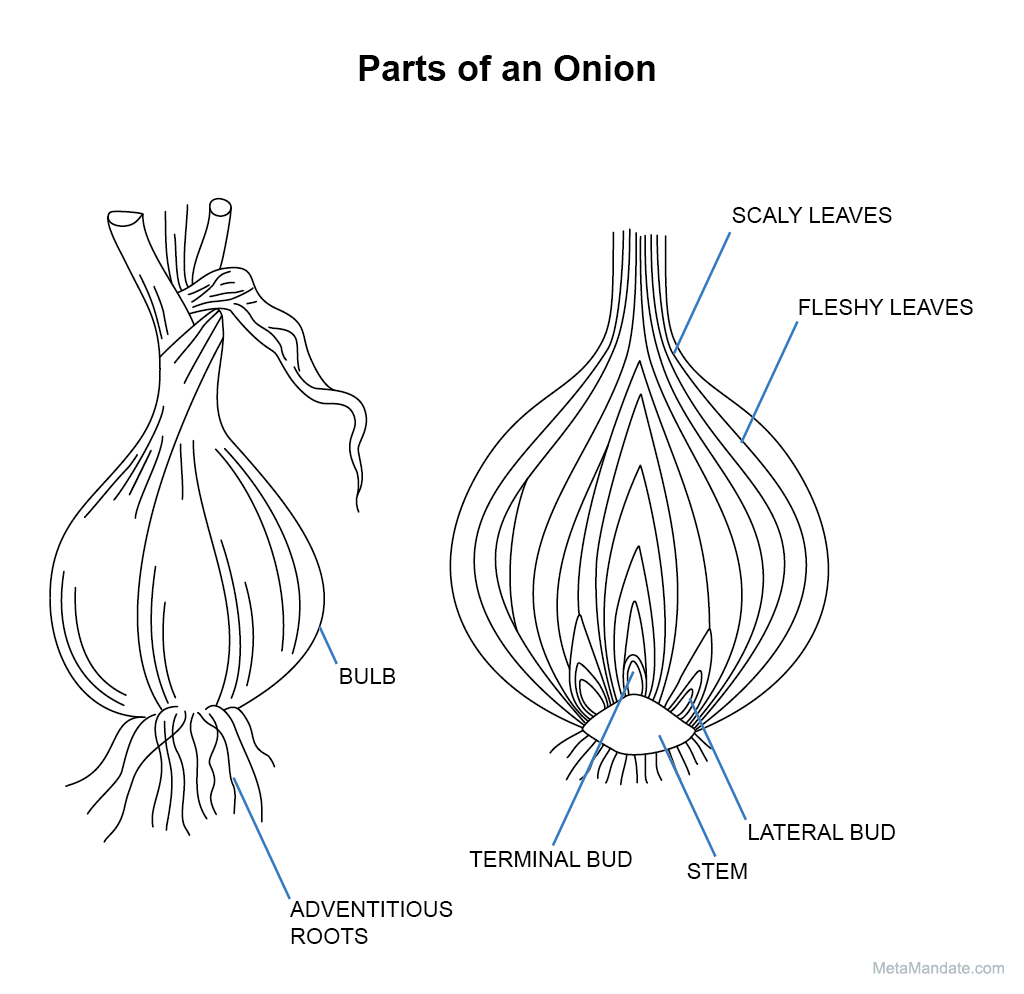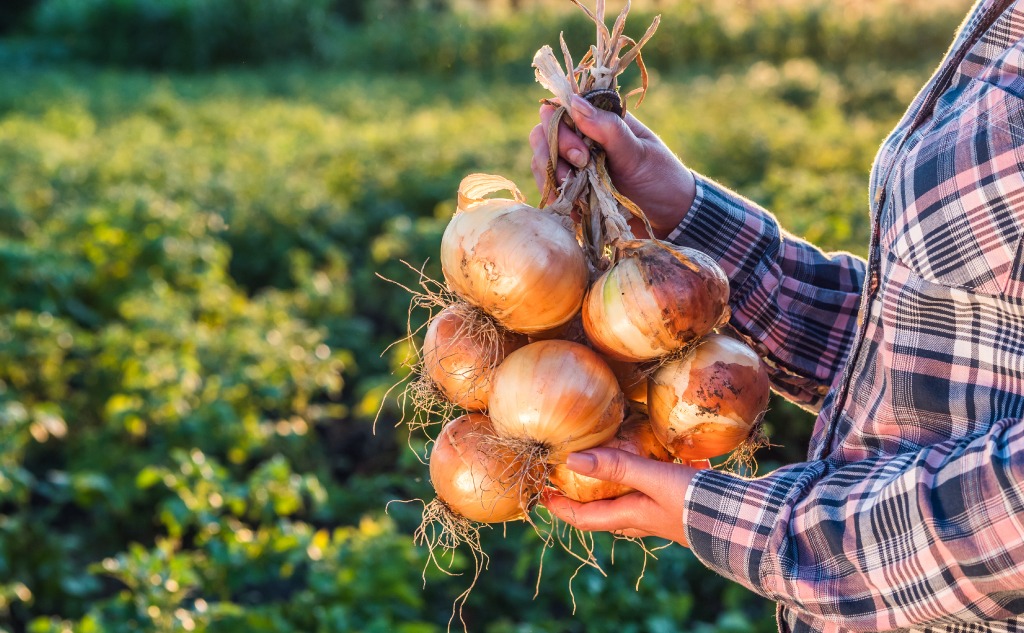Here are the 6 parts of an onion:
- Scaly leaves
- Fleshy leaves
- Terminal bud
- Axillary buds
- Condensed stem disk
- Adventitious roots
- Bulb
So if you want to learn all about the parts of an onion, their names, and their functions, then this article is for you.
Let’s jump right in!
Table of Contents
- #1 Scaly Leaves
- #2 Fleshy Leaves
- #3 Terminal Bud
- #4 Axillary Buds
- #5 Condensed Stem Disk
- #6 Adventitious Roots
- #7 Bulb

#1 Scaly Leaves
The scaly leaves are the first part you see when you pick up an onion. It’s the dried-up and crinkly leaves that you peel away before you use the onion.
They’re rougher, thinner, and less shiny than the fleshy leaves. Despite being very thin, each scaly leaf is still considered a separate layer.
Scaly leaves started out like normal fleshy leaves. Along the way, the outer leaves dry out and become papery thin. This gives more room for the inner leaves to grow in size as the plant matures.
The scaly leaves of the bulb are incapable of performing photosynthesis. Instead, the scaly leaves serve two main functions: storage and protection.
Many underground plants have covers to protect them against insects and soil friction. It adds a barrier to resist insects and erosion.
To some extent, scaly leaves are capable of storing water and nutrients. After all, they started as fleshy leaves.
The scaly leaves might not be as tasty as fleshy layers. However, dried onion peel is rich in flavonoids. You can use it for an extra punch of flavor in soups, rice, and bread.
#2 Fleshy Leaves
Onion is perhaps one of the most important bulb plants for humans, all thanks to the fleshy leaves.
These fleshy leaves are the second part of the onion bulb. They’re more plump and rich in active constituents.
The onion’s fleshy leaves don’t contain chlorophyll and they aren’t capable of photosynthesis. If they did have chlorophyll, it wouldn’t matter much. Remember that onion bulbs grow underground, away from sunlight.
The main function of fleshy onion leaves is storage. Many of the active constituents in the fleshy leaves are antioxidants. Here’s a list of the top nutrients stored in onions leaves:
- Flavonoids
- Anthocyanins
- Propanethial S-oxide
- Dimethyl Sulphate
- Water
- Vitamins (B and C)
- Minerals (magnesium, calcium, iron, potassium, phosphorus, and zinc)
Cutting the Fleshy Leaves of an Onions
The propanethial S-oxide in onion leaves is responsible for the irritating effect that onion layers have on the eyes. It’s an organosulfur compound that’s known for its lachrymatory action.
Whenever we cut fleshy onion leaves, we trigger a defense mechanism. In response, the enzyme alliinase is activated. Alliinase, in turn, increases the production of the volatile propanethial S-oxide.
A neat trick to reduce eye irritation is to freeze the onion for a few minutes before cutting it. The cold temperature deactivates the alliinase enzyme.
#3 Terminal Bud
Inside all the leaves, there’s a little hard bulge that’s called the terminal bud. Instead of being on top of a vertical stem, it’s enclosed within the bulb sitting on a disk-shaped condensed stem.
When we say terminal buds, we mean those at the end of a vertically growing end. However, since onions are bulbs (underground stems,) things are a little bit different here.
Buds are a bunch of embryonic cells waiting for an opportunity to divide and take form. Their main function is to help the plant grow.
In the case of onions, the terminal bud has the potential to form a new flowering shoot. This process is called vegetative propagation.
It might not be common knowledge, but onions are flowering plants. Onions are biennial and they spend the first year storing nutrients and water.
By the second year, the terminal buds would be ready to produce flowering shoots. The terminal buds can open up to around a meter-long inflorescence of small flowers. These flowers would, later on, produce the black seeds of onion plants.
Controlling the Terminal Buds
We don’t always get to see these flowers since the onions are usually harvested after the first year. If you let onions take their full growth cycle, you might have a chance at seeing their bolting process.
Bolting is not commercially useful since flowering and bearing fruit would consume up all the nutrients that were stored in the bulb to propagate.
There are many ways that farmers can prevent bolting. As a result, the terminal bud of the onions never gets to reach its full potential.
There are also ways to speed up the flowering of bulb plants like onions. Warm weather is one way to stimulate the terminal buds.
#4 Axillary Buds
While the onion has one terminal bud, it can have three to six axillary buds. They’re usually distributed around the terminal central bud.
Both the axillary and the terminal buds are carried on the upper side of the condensed discoid stem. They lay at the bottom of the onion bulb protected by the leaves.
It’s estimated that the axillary bugs begin to take form around the same time that the onion’s leaves start to swell and increase in size.
The terminal bud allows for vertical growth. Meanwhile, the axillary buds are responsible for lateral growth during propagation. In light of their main function, they might also be referred to as lateral buds.
The lateral shooting from axils is more productive than the vertical growth from the terminal bud. New branches sprout out from the axils and later they form their own daughter bulbs.
Controlling the Axillary Buds
Shoot apical meristem inhibits the axillary buds in what’s known as apical dominance. The apical (terminal) bud releases an auxin (a plant hormone) called IAA. IAA then acts to inhibit the propagation at the axils.
To put it simply, this means that the terminal buds might come as a priority before axillary ones. The plant will direct the nutrients towards vertical growth rather than lateral spreading. This vertical growth means that the flowering shoot will get better sunlight.
Cutting off the apical shoot cancels out the effect of apical dominance and gives a chance for lateral growth. However, you’ll rarely need to worry about having to cut the shoot in onion plants. The bulbs are harvested in the first year before the terminal bud starts bolting.
#5 Condensed Stem Disk
We keep saying that the entire onion is a modified stem structure. However, we also agree that the leaves and the buds grow on a disk-shaped stem. What’s up with that?
Well, in onions, there’s a condensed mass of cells that relate to the stem in function. It does the job of supporting other vital parts of the plant. It also delivers nutrients from the root to the bulb.
Regular vs. Condensed Stem Disks
Despite sharing a common function, the condensed disk differs from regular stems in a bunch of ways:
Position
The condensed steam disk can be found at the base of the onion bulb. This means that its full length lies underground. Meanwhile, regular stems are considered aerial parts.
Size
The stem disk is flattened down and much smaller than regular stems. It’s hardly the size of a coin. When it grows in size, it grows laterally to increase in diameter instead of vertically.
Composition
Unlike normal stems, the condensed stem disk has no nodes or intermediate nodes. It also isn’t divided into segments.
Uses
Unlike the peeled scaly leaves, the disk doesn’t have many domestic uses. Onion disks are generally discarded when cooking.
It’s not that they’re toxic or anything. It’s just that you probably won’t like its taste. The texture isn’t the most pleasing either.
In addition, the stem doesn’t store nutrients like the leaves do. That makes the nutritional value of the small condensed stem negligible.
Condensed Stem Disk During Flowering
During bolting, the condensed stem disk forms a small connection between the shoot that comes out of the terminal bud and the root system.
#6 Adventitious Roots
Adventitious roots are thin and they arise from a tuft. They’re different from taproots (main roots) in their number, size, and soil penetration ability.
Taproots can penetrate deep into the soil and they’re larger and wider. They also arise from a basal point. Meanwhile, adventitious roots can arise from leaves, nodes, and stems (both aerial and underground.)
A plant might have multiple taproots or a single taproot and a bunch of adventitious roots. In onion plants, adventitious roots replace the taproots.
Typically, the use of adventitious roots is supplementary to the taproot. Sometimes they’re even aerial and provide support to the plant.
Since onions have no taproots, the adventitious root system is the plant’s main nutrient supplier. Despite being thin, these roots are capable of absorbing all the plant’s water and mineral needs.
Root Apical Meristem
The onion root has an apical meristem just below the tip. The meristem tissue consists of cells that can rapidly divide. This plant’s chances at vegetative propagation and root regeneration.
It also allows the root to grow downwards into the ground. Keep in mind that onions are surface feeders and the root doesn’t dig very deep in the soil.
#7 Bulb
The onion bulb is made up of the parts discussed above.
